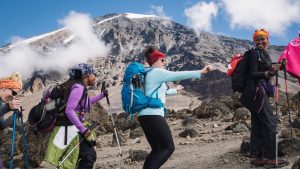Mount Kilimanjaro Climbers: An In-Depth Analysis
Every year, thousands of adventurers from around the world embark on the challenging journey to summit Mount Kilimanjaro, Africa’s highest peak. This iconic mountain, located in Tanzania, offers climbers a unique opportunity to test their physical and mental limits while experiencing breathtaking views and diverse ecosystems. In this article, we will delve into the demographic trends and success rates of Mount Kilimanjaro climbers, providing valuable insights for those considering taking on this remarkable challenge.
Demographic Trends
Mount Kilimanjaro attracts a diverse range of climbers, from seasoned mountaineers to first-time trekkers. According to data collected by Sunset Africa Safari, the leading tour operator for Kilimanjaro expeditions, the average age of climbers is between 30 and 50 years old. However, individuals of all ages, ranging from teenagers to seniors, have successfully reached the summit.
Gender distribution among Kilimanjaro climbers is relatively balanced, with approximately 60% male and 40% female participants. This highlights the inclusive nature of the mountain, welcoming adventurers of all genders to test their limits and conquer their fears.
Nationality also plays a significant role in the demographics of Mount Kilimanjaro climbers. While a large number of climbers come from Western countries such as the United States, United Kingdom, and Canada, there has been a noticeable increase in climbers from Asian countries such as Japan and China in recent years. This global representation adds to the diverse and multicultural experience of climbing Kilimanjaro.
Success Rates in Ascent
Successfully reaching the summit of Mount Kilimanjaro is no easy feat, as climbers must navigate challenging terrain, high altitudes, and unpredictable weather conditions. However, with proper training, preparation, and perseverance, climbers can increase their chances of a successful ascent.
Based on data from Sunset Africa Safari, the overall success rate for climbers attempting to reach the summit of Mount Kilimanjaro is approximately 65%. Factors that contribute to a successful ascent include physical fitness, acclimatization to high altitudes, and mental determination. Additionally, choosing a reputable tour operator with experienced guides and a well-planned itinerary can significantly increase the likelihood of reaching the summit.
It is important to note that success rates vary depending on the chosen route and duration of the climb. For example, the Machame route, known for its scenic views and gradual acclimatization, has a higher success rate compared to more challenging routes such as the Umbwe route. Likewise, longer climbs that allow for proper acclimatization have higher success rates than shorter, more rushed expeditions.
In conclusion, Mount Kilimanjaro offers climbers a unique and rewarding adventure, attracting individuals from diverse backgrounds and nationalities. By understanding the demographic trends and success rates of Kilimanjaro climbers, aspiring adventurers can better prepare for this challenging yet fulfilling experience. For booking inquiries and to embark on your own Kilimanjaro expedition, contact Sunset Africa Safari at info@sunsetafricasafari.com.


